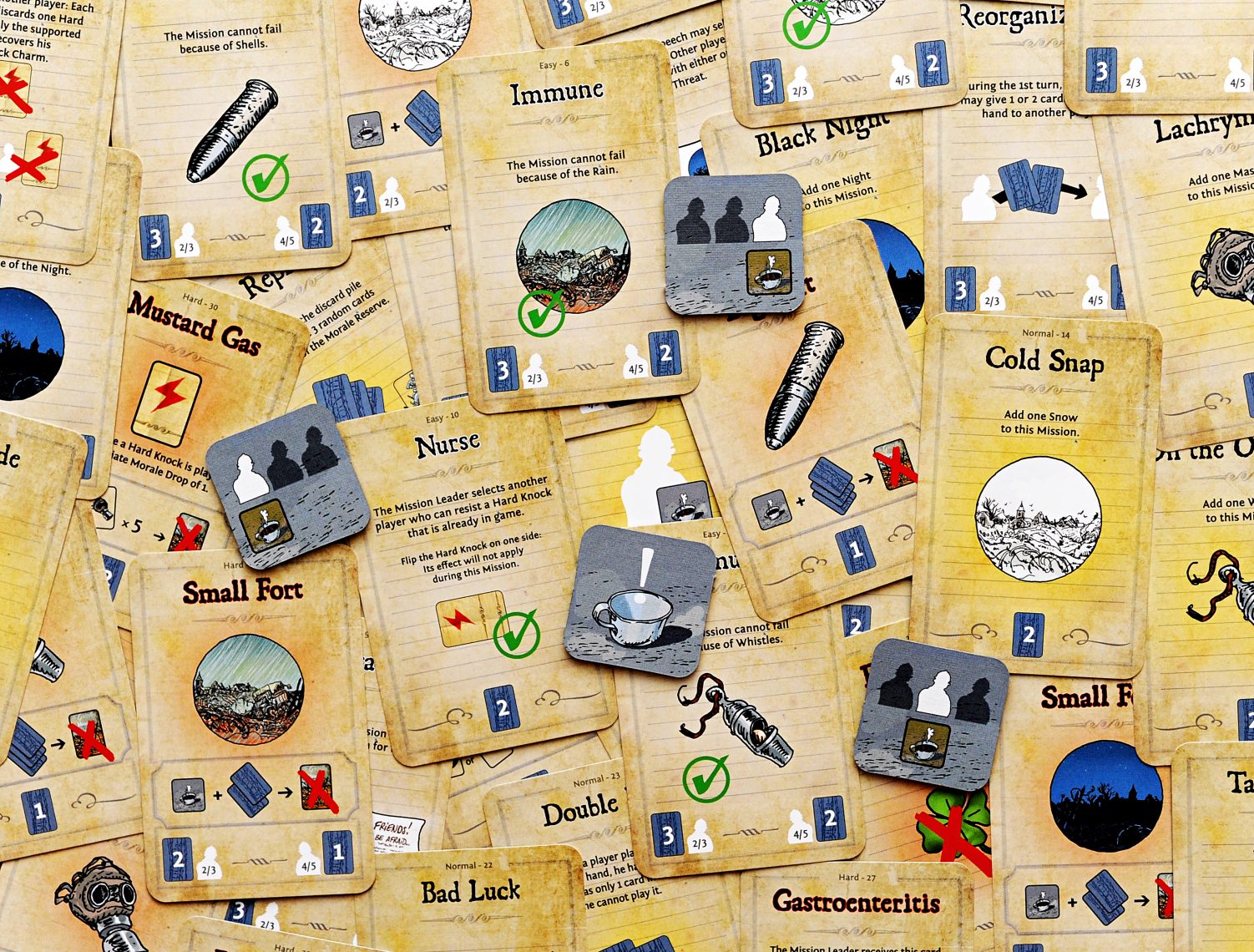
Last week I wrote about Coffee Roaster, a recent release for one player only. The muse has taken me down the path of thinking about my own favourite solitaire gaming experiences.
Why play solitaire? Well, sometimes there’s just no one around or available. Other times, you might be feeling introverted. Or maybe you are seeking a more puzzly, contemplative experience where you can take as much time as you like without worrying about stink-eyes or tappy feet from other players.
Some games are designed to be played solitaire; others can be played solitaire with alterations to the rules or extra components to simulate an AI. Designers continue to figure out new ways to challenge solitaire players more simply and elegantly. They are also aware that players like having the option to play solitaire; thus, games with a solitaire mode will sell more copies. Gamers even concoct their own solitaire rules when none are provided; one excellent example is this set of rules and cards for 2014’s La Granja.
That being said, just because a game can be played solo doesn’t mean it should. I have a bias against solo modes where you’re basically just trying to beat your previous best score or even some preset threshold set by the designers (Agricola comes to mind here). And games that involve negotiation, bluffing, or hidden information can never bring about the same experience solitaire than they do sitting around a table with a bunch of backstabby friends. (“You’re the traitor. No, I’m not–oh wait, I guess I am.”)
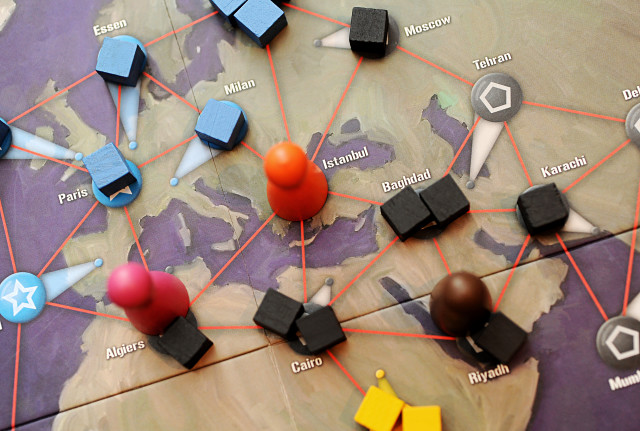
Pandemic
Many co-op games can be played solitaire–and in fact are often accused of being solitaire games prone to the “Pandemic Effect” whereby one player dominates and simply tells everyone else what to do. Since Pandemic’s release, designers have figured out different ways around this (Hanabi is one example), which is great because the Pandemic Effect is very real and very annoying. The downside is that Hanabi and games of that ilk are therefore unplayable solitaire.
Here are some currently-available games (listed roughly in order from lightest to heaviest) that are not only playable but enjoyable for those times when you’re stuck sick at home, or you’re out on the road, or you’re just not feeling sociable:
Light
- Al Cabohne is the solo (or two-player) standalone version of Bohnanza that I mentioned in my article on Uwe Rosenberg. You can read my take on Bohnanza there, but what I will say here is that Al Cabohne uses all the mechanics of Bohnanza and adds a gangster-bot player who plants, trades, and harvests beans using a simple yet ruthless set of rules which forces the player(s) to be as efficient as possible or risk going under (probably wearing cement shoes). Although obviously lacking the social/psychological element of the full game, Al Cabohne is fun and challenging in its own right.
- The Grizzled: At Your Orders is the expansion to the already-excellent game of heroism and camaraderie among les poilus in the trenches of WWI. The object is simply to endure The War To End All Wars by making it through the No Man’s Land deck in a series of Missions. Each Mission is a push-your-luck series of card draws which reminds me a bit of Incan Gold. Go too far and your soldiers receive Hard Knocks cards which have various (bad) effects. The squad loses if any player gets four Hard Knocks cards, or if time runs out. The At Your Orders expansion is what makes the system playable solitaire. There only real change to gameplay is the Solo Support tiles which randomly determine which of the three soldiers you’re playing gets a bit of a boost at the end of the Mission. Other than that plus a couple of simple rules tweaks the game plays really well–although you do miss out on the brotherhood of the trenches.
- Friday: Friedemann Friese, of Power Grid and 504 fame, released this gem back in 2011 and I think it still stands as one of the best solo game experiences. It’s a solitaire deck-builder, although the game lacks a “market” of cards to purchase. Instead, playing as a Crusoe-like character and starting with the standard beginning deck of weak cards,
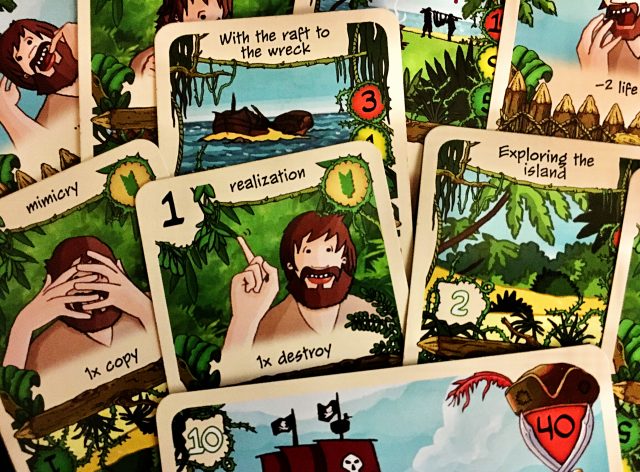 you “adventure” your way three increasingly-difficult times through a deck of Hazards. Using the cards in your hand, you “conquer” the hazards, converting them into powerful “knowledge” cards which join your deck. Knowledge cards allow you to manipulate your hand, the hazard deck, and even auto-defeat other hazards. Finally, you face the Boss (there are ten to choose from) in a final, epic battle. BUT you can’t just mill your own deck until you’re OP; every time you run through your deck you “age”, adding increasingly bad “aging” cards to your deck. The proper timing and use of your Knowledge Cards, plus cojones of steel in knowing when to push your luck, is the key to victory.
you “adventure” your way three increasingly-difficult times through a deck of Hazards. Using the cards in your hand, you “conquer” the hazards, converting them into powerful “knowledge” cards which join your deck. Knowledge cards allow you to manipulate your hand, the hazard deck, and even auto-defeat other hazards. Finally, you face the Boss (there are ten to choose from) in a final, epic battle. BUT you can’t just mill your own deck until you’re OP; every time you run through your deck you “age”, adding increasingly bad “aging” cards to your deck. The proper timing and use of your Knowledge Cards, plus cojones of steel in knowing when to push your luck, is the key to victory.
- Onirim is one of a series of solitaire games by Shadi Torbey, all published by Z-Man games and featuring the dreamy artwork of Élise Plessis. I could have put any of them on the list but chose this one because it is the most straightforward and was recently ported to iOS. In Onirim you are a dreamer trapped in a dream-maze trying to unlock a series of eight differently-coloured dream-doors before time runs out or the Nightmares break through. The maze is represented abstractly by a line of cards you play from your hand. The deck you play with is composed of four coloured suits composed of differing numbers of three possible symbols: sun; moon; key. Play three cards in a row from the same suit without playing the same symbol twice in a row and you get to look through your deck for a door of that colour and set it aside–huzzah! you passed another checkpoint! Or discard a key under the right circumstances and accomplish the same thing. But draw a Nightmare, and you have to choose a Bad Thing to happen from a list of three Very Bad Things. Onirim is not easy to win, and if you get bored of it don’t worry, there are seven (!) expansions that come with the second edition that you can use to spice things up.
- Tiny Epic Galaxies: Scott Almes is some kind of genius. His series of “Tiny Epic Games” are what they say they are: epic games in relatively small boxes (but I guess “Relatively Small Epic Galaxies” doesn’t trip of the tongue quite as melodiously). Galaxies is an excellent game in its
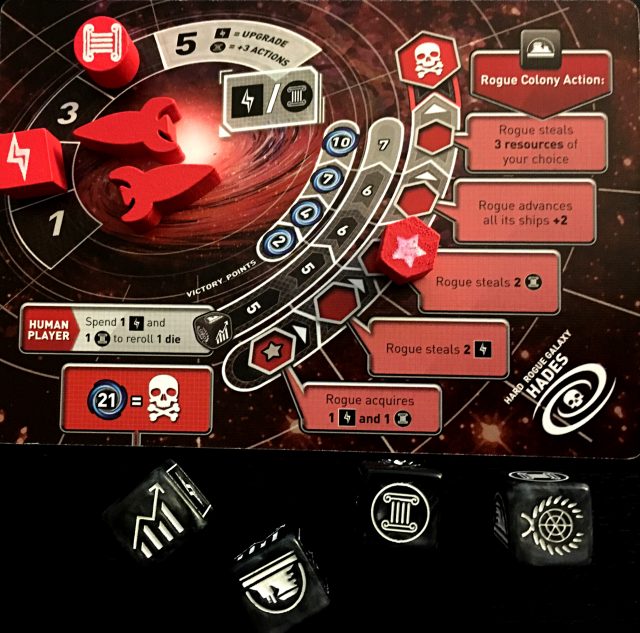 own right, using an Alien Frontiers-ish dice-rolly base combined with a Glory to Rome-anesque role selection and following mechanic to produce a 4X-in-Space game in miniature. But even more impressively, the solo variant is fun all by itself, and achieved simply with a few rules tweaks and using “bot” players printed on the reverse of the regular player mats. There are several levels of difficulty you can choose, and it is not easy to win. The recent expansion Beyond the Black is playable solo, too. Genius, I say!
own right, using an Alien Frontiers-ish dice-rolly base combined with a Glory to Rome-anesque role selection and following mechanic to produce a 4X-in-Space game in miniature. But even more impressively, the solo variant is fun all by itself, and achieved simply with a few rules tweaks and using “bot” players printed on the reverse of the regular player mats. There are several levels of difficulty you can choose, and it is not easy to win. The recent expansion Beyond the Black is playable solo, too. Genius, I say!
Medium
- Legends of Andor: is a co-operative game that plays extremely well solitaire, since in essence it is a puzzle game disguised as a fantasy RPG. You cannot play this game like a Skyrim take-an-arrow-in-the-knee kind of
 way; you need to math your way through six increasingly-difficult scenarios ranging over a fantasy world. You do lose a bit of the element of surprise after the first time out, but unlike, say, T.I.M.E. Stories, the scenarios are definitely replayable because some events and combat depend on chance. Last year’s Legends of the North expansion adds a whole new board, new scenarios, and new mechanics to keep things fresh and challenging.
way; you need to math your way through six increasingly-difficult scenarios ranging over a fantasy world. You do lose a bit of the element of surprise after the first time out, but unlike, say, T.I.M.E. Stories, the scenarios are definitely replayable because some events and combat depend on chance. Last year’s Legends of the North expansion adds a whole new board, new scenarios, and new mechanics to keep things fresh and challenging.
- Russian Railroads: German Railroads is an expansion to 2013’s Russian Railroads which includes a solo mode as well as two other “modules” which can be bolted onto the base game. The heart of the game is worker placement, with many paths to victory via the extent and spread of your rail network and industrial prowess. The solo version uses a bot in the form of an Automa deck. Pioneered by Morten Pederson in games like Viticulture and Scythe, Automas are decks of cards which randomly determine your AI opponent’s actions and otherwise mess with your optimal play. Although the goal of the solo version is the cop-out of “beat your high score”, if you’re looking to scratch that Euro itch and there’s no one around, German Railroads’ solo mode does the job very well.
- Terraforming Mars was one of 2016’s big hits (at least among my friends) and I wrote about it back in April. It comes with a challenging solitaire mode where you have exactly fourteen generation-turns to bring Mars up to code all by yourself. This is no mean feat, Spaceman Spiff. The great thing about this mode is that it requires no AI rules and only a couple of little rules tweaks. Since each corporation has its strengths and weaknesses, each play can be different. Playing TM solitaire is a great way to learn the cards and efficient strategies.
- Mound Builders is one of many “States of Siege” games from Victory Point Games using the same basic system. Each one uses a tower-defence mechanic whereby you are protecting a sacred space in the middle of the board which
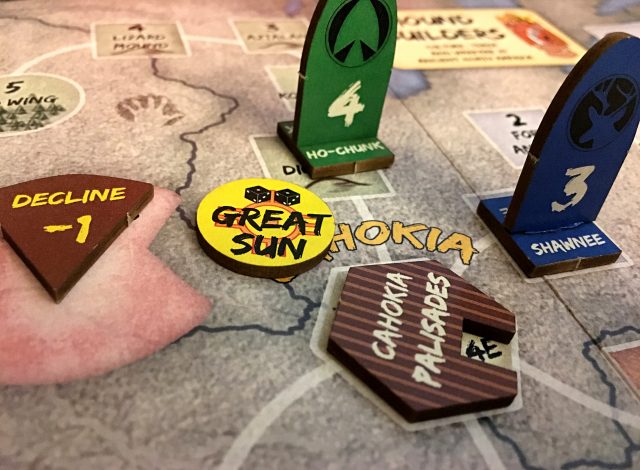 you must protect at all costs. Unfortunately, it is under attack from various directions, each represented by a separate track with an attacking army on it hungering for you. Each turn you draw a card which tells you which bad guys advance along which track(s), what other events occur (usually bad). Then you get a chance to respond with a varying number of “actions” which include counterattacking, shoring up defences, and so on. I own several games in the series and enjoy all of them, but chose this one for its very unusual theme as you play the pre-Columbian Hopewell and Mississippi nations expanding and trading in the early game and then contracting and holding out as long as possible once the Europeans arrive. Mound Builders halfway belongs in the next section by virtue of its ruleset, but the States of Siege system is straightforward compared to the complexity of the Heavy Hitters to come.
you must protect at all costs. Unfortunately, it is under attack from various directions, each represented by a separate track with an attacking army on it hungering for you. Each turn you draw a card which tells you which bad guys advance along which track(s), what other events occur (usually bad). Then you get a chance to respond with a varying number of “actions” which include counterattacking, shoring up defences, and so on. I own several games in the series and enjoy all of them, but chose this one for its very unusual theme as you play the pre-Columbian Hopewell and Mississippi nations expanding and trading in the early game and then contracting and holding out as long as possible once the Europeans arrive. Mound Builders halfway belongs in the next section by virtue of its ruleset, but the States of Siege system is straightforward compared to the complexity of the Heavy Hitters to come.
Heavy
- Scythe. It’s #7 on BGG and deservedly so–it really deserves an article all its own. Set on the Eastern Front of an alternate post-WWI steampunk universe where giant mechs roam the steppes, Scythe is a tight web of interlocking mechanisms where you win by attaining six “achievements” (out of a possible ten) before any of your rivals. Those achievements could be military, economic, or
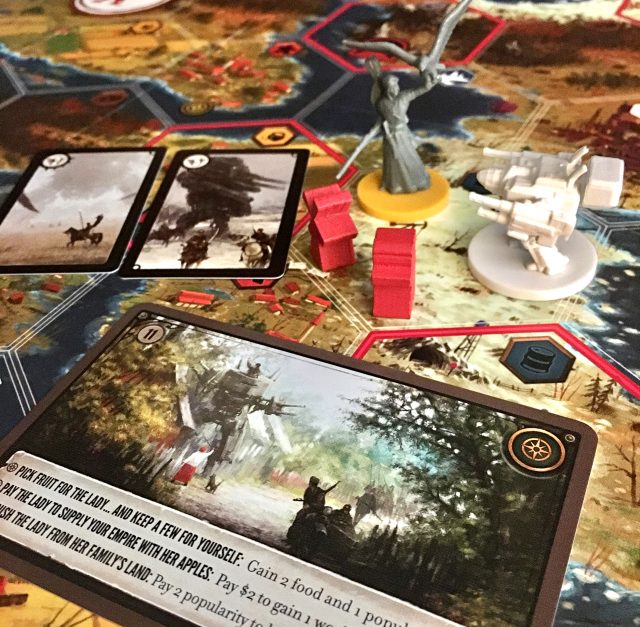 political, and although each quasi-historical faction has strengths which make certain achievements easier, there is plenty of room to maneuver–figuratively, that is. In a literal sense the territory you and your opponents are squabbling over is small indeed. The game shines with four players, in my opinion, but other player counts are viable, especially if you use the Automas provided. Using the Automas requires a bit of work at first, particularly when it comes to understanding priorities for movement and combat, but once you’ve internalized the ideas things move along quite nicely. There is even a ScytheKick app which allows you to run multiple Automa at once and very cleanly at that. Scythe is an amazing game; the fact that its Automas allow you to play it solitaire is icing on the Kuchen.
political, and although each quasi-historical faction has strengths which make certain achievements easier, there is plenty of room to maneuver–figuratively, that is. In a literal sense the territory you and your opponents are squabbling over is small indeed. The game shines with four players, in my opinion, but other player counts are viable, especially if you use the Automas provided. Using the Automas requires a bit of work at first, particularly when it comes to understanding priorities for movement and combat, but once you’ve internalized the ideas things move along quite nicely. There is even a ScytheKick app which allows you to run multiple Automa at once and very cleanly at that. Scythe is an amazing game; the fact that its Automas allow you to play it solitaire is icing on the Kuchen.
- Mage Knight is one of my all-time desert-island favorites, especially because it works so well as a solitaire game. You play, well…a mage who is also a knight, sort of a spell-tank übermensch roaming around a modularly-constructed countryside slaying beasties, recruiting sidekicks, and ultimately taking on heavily-fortified cities. It’s not a deckbuilder per se, rather a card-drafting, mana-dice-rolling, puzzly hand management behemoth of a game. Mage Knight practically encourages analysis paralysis, and unless you’re playing it co-op style there can be huuuuuge amounts of downtime as you wait for the other players to figure out their turns. Which is why playing solitaire is so satisfying, since you can take as much bloody time as you want, thank you very much. The rules are a bit of a mess, spread over two rulebooks, but there are great player aids you can download from BGG to help you through. Mage Knight was re-implemented and made slightly easier as Star Trek: Frontiers in 2016, but for reasons I wrote about at the end of last year I would stick to Mage Knight unless you’re a die-hard Trekker who hates fantasy.
- RAF was a very innovative design when it was released in 1986 by now-defunct West End Games. In 2009 it was updated by its original designer, the amazing John H. Butterfield, so that now in addition to playing the stalwart Brits staving off Operation Sealion you can, if the mood takes you (and you feel like digesting whole new sets of rules), play the near-almighty Luftwaffe and try to bring England to its knees. You can also play PvP. The game is highly complex, relying heavily on decks of cards for events and dicerolls for combat. As a clouds-eye view of the challenges faced by both sides in this aerial campaign, it is hard to beat RAF.
- The Barbarossa Campaign from Victory Point Games represents the pinnacle of solo wargame design at the strategic level, in my eyes. Playing as the German Army, your job is to knock the Soviet Union out of the war–or failing that, to hold on to as much territory as possible by
 1945. The game has a classic hex-and-counter chassis but uses a unique combat system of chit-pulling to simulate the vagaries of the battlefield and the changing tide of war over time. Economic and political factors are built in as well. There are literally dozens of games about the Eastern Front out there, but this is the best one you can play solitaire.
1945. The game has a classic hex-and-counter chassis but uses a unique combat system of chit-pulling to simulate the vagaries of the battlefield and the changing tide of war over time. Economic and political factors are built in as well. There are literally dozens of games about the Eastern Front out there, but this is the best one you can play solitaire.
- Fire in the Lake, about the Vietnam conflict, is one of several games in GMT Games’ COIN Series, games about guerilla warfare and counter-insurgency throughout history. The series includes games about the Cuban Revolution of 1959, the Columbian Civil War, the US War of Independence, and the ongoing efforts in Afghanistan, all of which use the same basic system which is descended ultimately from Twilight Struggle, in which players vie for control of various areas on the board through the play of cards which have multiple uses. The COIN Series takes things to the next level, though, by providing for up to four players taking the role of various factions involved in the fighting. Depending on the game, some factions might be more-or-less allied but with different (and somewhat conflicting) victory conditions. Furthermore, the COIN games are never just about combat; there are political and economic factors which must be considered at every turn–which naturally makes for long and complex games. From the beginning the COIN series has provided for “bot” play so that fewer than four players can still partake and enjoy. Proper understanding of how to use the bots, as with Scythe, takes a lot of extra brain-power, but if you have the will and the time to do so you will be rewarded.
- Conflict of Heroes: Awakening the Bear (Solo Expansion), by Academy Games, covers the same war as The Barbarossa Campaign but at the other end of the scale–small-unit tactics. This is not Memoir ‘44–which is not to knock Memoir, it’s a great game–but Awakening the Bear requires a lot more effort to get into, and then again to learn and understand the solo expansion rules. The game simulates the to-and-fro of the battlefield by having players taking turns ordering, moving, and fighting with individual units in an unpredictable order instead of all of one side’s guys moving and firing at once. Each preconstructed Mission is different, some with one side or or the other defending statically, others with both sides moving towards each other, and so on. The solo rules add an Automa-like system with separate Order and Action card decks, along with an event-driven turn track for each of the solo Missions. If you spring for the Firefight Generator you can randomly generate an infinite number of additional Missions. Right now there is no better system for solo tactical wargaming, in my opinion.
It was hard enough keeping my list down to fifteen; there are plenty of other great solitaire games out there–and even more you can find second-hand from the classic days of Avalon Hill and SPI (if you can find a copy of Ambush!, snap it up). Playing solitaire is a necessary evil for some, a last-choice option for others, and an occasional diversion for the rest of us. What do you enjoy playing when you’re all on your ownsome?
-
David is the Managing Editor of the DWP. He learned chess at the age of five and has been playing tabletop games ever since. His collection currently consists of about 600 games, which take up way too much space. His game "Odd Lots" won the inaugural TABS Game Design Contest in 2008. He is currently Managing Editor of The Daily Worker Placement.
All in all he's pretty smug about his knowledge of games and game
design.
View all posts

 you “adventure” your way three increasingly-difficult times through a deck of Hazards. Using the cards in your hand, you “conquer” the hazards, converting them into powerful “knowledge” cards which join your deck. Knowledge cards allow you to manipulate your hand, the hazard deck, and even auto-defeat other hazards. Finally, you face the Boss (there are ten to choose from) in a final, epic battle. BUT you can’t just mill your own deck until you’re OP; every time you run through your deck you “age”, adding increasingly bad “aging” cards to your deck. The proper timing and use of your Knowledge Cards, plus cojones of steel in knowing when to push your luck, is the key to victory.
you “adventure” your way three increasingly-difficult times through a deck of Hazards. Using the cards in your hand, you “conquer” the hazards, converting them into powerful “knowledge” cards which join your deck. Knowledge cards allow you to manipulate your hand, the hazard deck, and even auto-defeat other hazards. Finally, you face the Boss (there are ten to choose from) in a final, epic battle. BUT you can’t just mill your own deck until you’re OP; every time you run through your deck you “age”, adding increasingly bad “aging” cards to your deck. The proper timing and use of your Knowledge Cards, plus cojones of steel in knowing when to push your luck, is the key to victory. own right, using an Alien Frontiers-ish dice-rolly base combined with a Glory to Rome-anesque role selection and following mechanic to produce a 4X-in-Space game in miniature. But even more impressively, the solo variant is fun all by itself, and achieved simply with a few rules tweaks and using “bot” players printed on the reverse of the regular player mats. There are several levels of difficulty you can choose, and it is not easy to win. The recent expansion Beyond the Black is playable solo, too. Genius, I say!
own right, using an Alien Frontiers-ish dice-rolly base combined with a Glory to Rome-anesque role selection and following mechanic to produce a 4X-in-Space game in miniature. But even more impressively, the solo variant is fun all by itself, and achieved simply with a few rules tweaks and using “bot” players printed on the reverse of the regular player mats. There are several levels of difficulty you can choose, and it is not easy to win. The recent expansion Beyond the Black is playable solo, too. Genius, I say! way; you need to math your way through six increasingly-difficult scenarios ranging over a fantasy world. You do lose a bit of the element of surprise after the first time out, but unlike, say, T.I.M.E. Stories, the scenarios are definitely replayable because some events and combat depend on chance. Last year’s Legends of the North expansion adds a whole new board, new scenarios, and new mechanics to keep things fresh and challenging.
way; you need to math your way through six increasingly-difficult scenarios ranging over a fantasy world. You do lose a bit of the element of surprise after the first time out, but unlike, say, T.I.M.E. Stories, the scenarios are definitely replayable because some events and combat depend on chance. Last year’s Legends of the North expansion adds a whole new board, new scenarios, and new mechanics to keep things fresh and challenging. you must protect at all costs. Unfortunately, it is under attack from various directions, each represented by a separate track with an attacking army on it hungering for you. Each turn you draw a card which tells you which bad guys advance along which track(s), what other events occur (usually bad). Then you get a chance to respond with a varying number of “actions” which include counterattacking, shoring up defences, and so on. I own several games in the series and enjoy all of them, but chose this one for its very unusual theme as you play the pre-Columbian Hopewell and Mississippi nations expanding and trading in the early game and then contracting and holding out as long as possible once the Europeans arrive. Mound Builders halfway belongs in the next section by virtue of its ruleset, but the States of Siege system is straightforward compared to the complexity of the Heavy Hitters to come.
you must protect at all costs. Unfortunately, it is under attack from various directions, each represented by a separate track with an attacking army on it hungering for you. Each turn you draw a card which tells you which bad guys advance along which track(s), what other events occur (usually bad). Then you get a chance to respond with a varying number of “actions” which include counterattacking, shoring up defences, and so on. I own several games in the series and enjoy all of them, but chose this one for its very unusual theme as you play the pre-Columbian Hopewell and Mississippi nations expanding and trading in the early game and then contracting and holding out as long as possible once the Europeans arrive. Mound Builders halfway belongs in the next section by virtue of its ruleset, but the States of Siege system is straightforward compared to the complexity of the Heavy Hitters to come. political, and although each quasi-historical faction has strengths which make certain achievements easier, there is plenty of room to maneuver–figuratively, that is. In a literal sense the territory you and your opponents are squabbling over is small indeed. The game shines with four players, in my opinion, but other player counts are viable, especially if you use the Automas provided. Using the Automas requires a bit of work at first, particularly when it comes to understanding priorities for movement and combat, but once you’ve internalized the ideas things move along quite nicely. There is even a ScytheKick app which allows you to run multiple Automa at once and very cleanly at that. Scythe is an amazing game; the fact that its Automas allow you to play it solitaire is icing on the Kuchen.
political, and although each quasi-historical faction has strengths which make certain achievements easier, there is plenty of room to maneuver–figuratively, that is. In a literal sense the territory you and your opponents are squabbling over is small indeed. The game shines with four players, in my opinion, but other player counts are viable, especially if you use the Automas provided. Using the Automas requires a bit of work at first, particularly when it comes to understanding priorities for movement and combat, but once you’ve internalized the ideas things move along quite nicely. There is even a ScytheKick app which allows you to run multiple Automa at once and very cleanly at that. Scythe is an amazing game; the fact that its Automas allow you to play it solitaire is icing on the Kuchen. 1945. The game has a classic hex-and-counter chassis but uses a unique combat system of chit-pulling to simulate the vagaries of the battlefield and the changing tide of war over time. Economic and political factors are built in as well. There are literally dozens of games about the Eastern Front out there, but this is the best one you can play solitaire.
1945. The game has a classic hex-and-counter chassis but uses a unique combat system of chit-pulling to simulate the vagaries of the battlefield and the changing tide of war over time. Economic and political factors are built in as well. There are literally dozens of games about the Eastern Front out there, but this is the best one you can play solitaire.
Masmorra is a fun, solo, dungeon-crawl dice chucker.
Thanks for this article, I end up playing solo quite a bit due to various circumstances. My current favourites, in order of preference are:
1. Race for the Galaxy (with Gathering Storm expansion)
2. Mice and Mystics
3. Burgle Bros (this is a fantastic game, best with friends of course, but a fun solo too… just put on the Ocean’s Eleven soundtrack for atmosphere)
4. Tiny Epic Galaxies
5. Lord of the Rings LCG
I have noticed you don’t monetize your page, don’t waste your traffic, you can earn extra cash every
month because you’ve got hi quality content.
If you want to know how to make extra $$$,
search for: Mertiso’s tips best adsense alternative